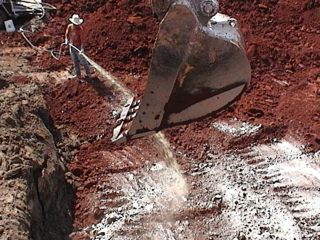Guidance for Remediation Waste Management at Hazardous Waste Cleanup Facilities
Waste generated from the cleanup of environmental contamination, known as remediation waste, is an important part of the RCRA hazardous waste program, because environmental media contaminated by the release of a hazardous waste often retains the classification of hazardous waste. As opposed to on-going waste management, remediation activities often involve less concentrated wastes, one-time activities, and shorter-term activities. EPA or an authorized state or territory oversees remediation activities.
The regulations regarding remediation wastes are essential to ensure that facilities properly clean up contaminated areas. To provide regulatory flexibility while protecting human health and the environment, EPA updated the Requirements for Management of Hazardous Contaminated Media Rule and issued Amendments to the original Corrective Action Management Units Rule. In addition, EPA issued a series of regulations and policies to address these issues.
On this page:
- Requirements for the Management of Hazardous Contaminated Media
- Contained-in Policy
- Corrective Action Management Units and Temporary Units
- Additional Remediation Waste Guidance
Requirements for the Management of Hazardous Contaminated Media Rule

In order to mitigate the impact of RCRA hazardous waste management standards on the corrective action program, EPA promulgated streamlined regulations that allow the use of alternate remediation waste permits and unit standards. These alternative standards ensure cleanups are fully protective while eliminating some of the regulatory hurdles associated with waste management. For example, the Agency promulgated a modified version of a permit, the Remedial Action Plan. Unlike the traditional RCRA permit, the RAP is tailored to the needs of a facility that manages remediation waste.
The following documents pertain to the Requirements for Management of Hazardous Contaminated Media (known as HWIR-Media) rule including the Federal Register notices for the proposed and final rule as well as associated information requests and supporting materials. This rule addresses the major RCRA Subtitle C management requirements that are considered the biggest causes of problems and delays for cleanups. These requirements include the land disposal restrictions, minimum technological requirements, and RCRA permitting procedures.
- Final Rule: Requirements for Management of Hazardous Contaminated Media (pdf) (1998) (597 KB).
- Proposed Rule: Requirements for Management of Hazardous Contaminated Media (pdf) (1996) (744 KB).
Contained-In Policy
In the Requirements for Management of Hazardous Contaminated Media final rule (pdf) (1998) (597 KB), EPA identified the application of three RCRA requirements to remediation wastes as the biggest problems to address: LDRs, MTRs, and permitting. You can find the contained-in policy in this rule starting on page 65877.
Corrective Action Management Units and Temporary Units
CAMUs are special units created under the RCRA to facilitate treatment, storage, and disposal of hazardous wastes managed for implementing cleanup, and to remove the disincentives to cleanup that the application of RCRA to these wastes can sometimes impose. A CAMU is used only for managing CAMU-eligible wastes for implementing corrective action or cleanup at the facility. A CAMU must be located within the lower contiguous property under the control of the owner or operator where wastes to be managed in the CAMU originated.
The CAMU regulations were originally promulgated on February 16, 1993. EPA amended the 1993 CAMU rule in 2002 with six changes. The following documents provide the “Amendments to the original Corrective Action Management Units Rule” and supplemental information.
- The CAMU Rule:
Additional Remediation Waste Guidance
The following resources provide guidance on EPA’s regulations and policies for remediation waste management:
| Name of Document(s) | Description of Document(s) |
|---|---|
|
|
Management of Remediation Waste Under RCRA, consolidates existing guidance on the RCRA regulations and policies that most often affect remediation waste management. The associated chart summarizes the document and can be used to quickly identify possible remediation waste management strategies and to compare one remediation waste management approach to another. |
| Land Disposal Restrictions (LDR) Treatment Standards for Contaminated Debris (pdf) (78 MB) |
|
| Area of Contamination and Corrective Action Management Units Compendium(pdf) (333.77 KB) |
EPA developed this compendium of supporting memos, regulations, and policies about areas of contamination (certain discrete areas of generally dispersed contamination) and corrective action management units (areas within facilities that are used only for managing remediation wastes for implementing corrective action or cleanup at the facilities). |
| Determination of When Contamination is Caused by Listed Hazardous Wasted | |
| Site-Specific LDR Treatment Variances |
|
| Treatability Studies Exclusion Rule |
|
Exemption for Ninety Day Accumulation in the March 24, 1996, Federal Register notice (pdf)(68 MB) |
This document is in Title 40 of the Code of Federal Regulations regarding temporary storage of hazardous waste. EPA allows for limited on-site storage without the need for a permit or interim status (90 days for over 1000 kg/month generators and 180/270 days for 100-1000 kg/month generators). EPA believes that treatment in accumulation tanks or containers is permissible under the existing rules, provided the tanks or containers are operated strictly in compliance with all applicable standards. |
|
|
These documents below are memorandum regarding RCRA permit waivers. In general, a State authorized to conduct the RCRA base permit program will have the authority to waive RCRA permit requirements for State Superfund actions as long as:
|
Exemption from Title 40 of the Code of Federal Regulations Part 264 Requirements for People Engaged in the Immediate Phase of a Spill Response |
|
Changes During Interim Status to Comply with Corrective Action Requirements (pdf)(91.3 MB) |
|
|
Emergency Permits |
|
| Temporary Authorizations at Permitted Facilities |
This rule provides EPA with the authority to grant a permittee temporary authorization, without prior public notice and comment, to conduct activities necessary to respond promptly to changing conditions. Read the discussion on temporary authorization on pages 37919 through 37921. |
